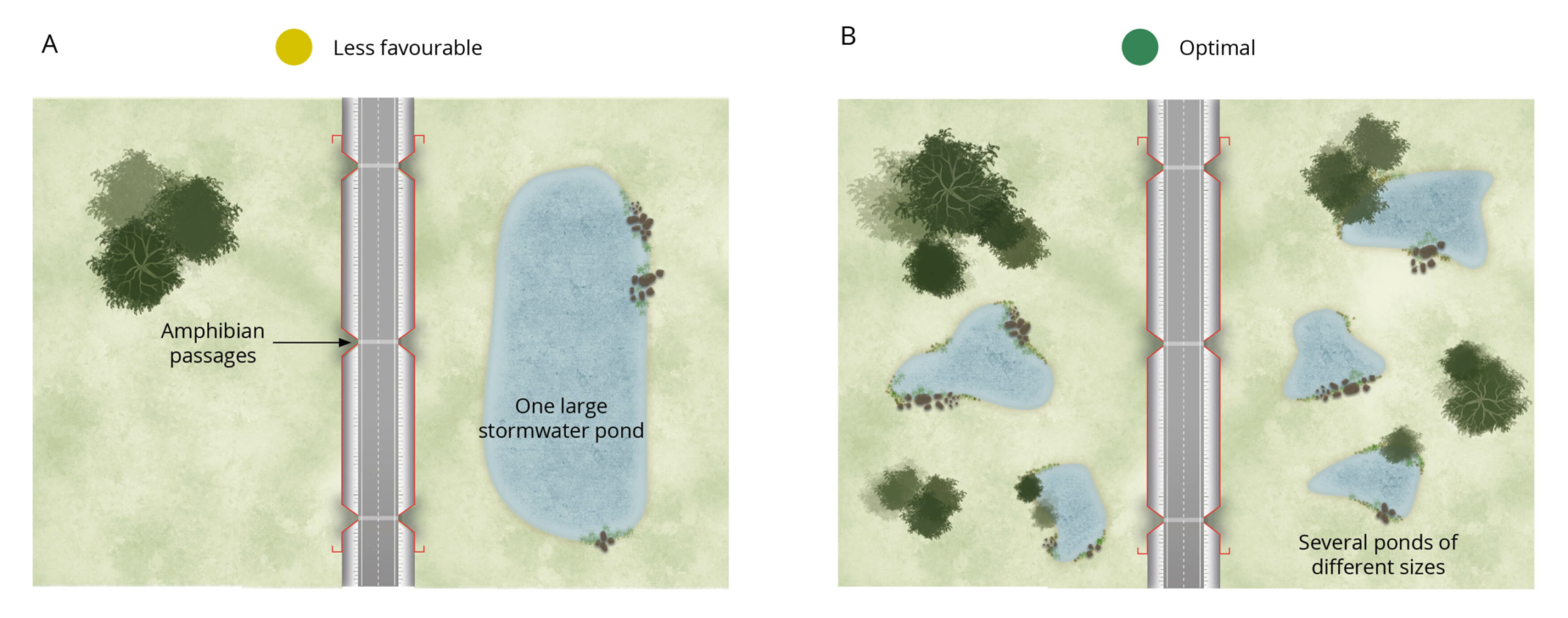Transport infrastructure is also associated with aquatic habitats. These include blue areas such as drainage systems which have areas temporarily or permanently flooded, perimetral ditches to collect runoff water, culverts or other types of underpasses to guarantee waterway and river crossing and retention ponds. All of these areas may host not only terrestrial but also aquatic species and with appropriate design and maintenance, could help benefit biodiversity.
Water quality is a main aspect to be considered before undertaking any restoration initiatives. Retention ponds located on motorways and main roads with heavy traffic intensity are not suitable to host wildlife if runoff water is not treated to reduce chemical pollutants.
Complementary information is provided in Chapter 7 – Maintenance and particularly in sheets 7.4.16 Management of retention ponds to host wildlife, 7.4.8 Maintenance of adapted culverts and 7.4.7 Maintenance of adapted viaducts, wildlife and multiuse underpasses.
Retention ponds
Retention ponds can provide several ecosystem services as well as benefits for biodiversity. They are an effective measure to mitigate chemical pollution (see Section 5.6.3 – Chemical pollution), but they can also contribute to the mitigation of flooding caused by climate change (see Section 5.9.1 – Implications for biodiversity of measures for climate change adaptation), facilitate carbon sequestration, and provide biodiversity hotspots.
Retention ponds may provide reproduction and foraging possibilities for animals such as amphibians and can contain comparable biodiversity to unmanaged wetlands in urban areas. It is important they are properly designed and maintained so that they do not become ecological traps (see Chapter 1 – Ecological effects of infrastructure).
When ponds cannot provide quality habitats or/and may be a cause of wildlife mortality, the access to wildlife (including amphibians) must be prevented with appropriate fencing.
To provide suitable habitats for biodiversity in retention ponds, the following characteristics should be taken into consideration (Figure 5.7.12; Figure 5.7.13; Figure 5.7.14).
- Ensuring water is free of pollutants or that the concentration of these is not harmful to wildlife.
- Ensuring that animals that enter in the pond can escape it and are not trapped with a risk of drowning.
- Including a diversity of native species, while avoiding IAS.
- Avoiding nutrient-rich soil which can increase the chance of causing eutrophication of the water and loss of habitat quality.
- Using clay soil as a preference.
- Providing a range of different depths, ensuring some shallower areas which are selected by amphibians for reproduction, due to warmer conditions and fewer predators, assisting in egg development.
- Providing a gentle slope on the banks to allow amphibians climb in and out more easily.
- Creating several ponds close to each other as part of a complex habitat is better than one large pond because it increases habitat connectivity and provides better chances for species survival. Diversifying the water level of these ponds would benefit species with different requirements, providing suitable habitats for a bigger number of species.
- Providing maintenance adapted to protect wildlife. While drainage and cleaning tasks are being undertaken, rescue and removal of wildlife could be required. Such activities must not be undertaken during amphibian breeding seasons and other vulnerable periods.
The presence of bodies of water at airports is not recommended due to the strong possibility of attracting birds and the removal of all ponds, canals etc., is advised. If removal is not possible, remaining water bodies should be covered or managed to reduce their attractiveness to wildlife to avoid the risk of mortality and corresponding safety issues (Figure 5.7.15).
Escape ramps from drains
- Perimeter ditches for drainage (U-shape ditches) are often constructed of metal or other materials which offer little grip. They are often too big to facilitate the exit of small vertebrates and invertebrates, which fall in and drown. Ramps should be installed to offer the possibility of escape. In areas with spawning amphibians, a dense wire mesh placed under the cover of the drain prevents animals from falling in. However, appropriate and periodic maintenance should be performed to avoid clogging. Amphibians may survive the journey from drains to water purification plants and therefore need purpose-built escape ramps at the plant to get out. These ramps can also be installed in retention ponds or any other bodies of water within the ROW if the substrate is not natural.
- The ramps should have a rough surface to provide good grip (Figure 5.7.16).
- The end of a ramp should be ~ 15 cm higher than the surrounding terrain.
- The end of a ramp should be fitted with wire netting to prevent small predators from climbing onto the ramp. The mesh size should be about the same size as the gap in the metal cover.
- Ramps in U-shape ditches are placed on the verge side only.




